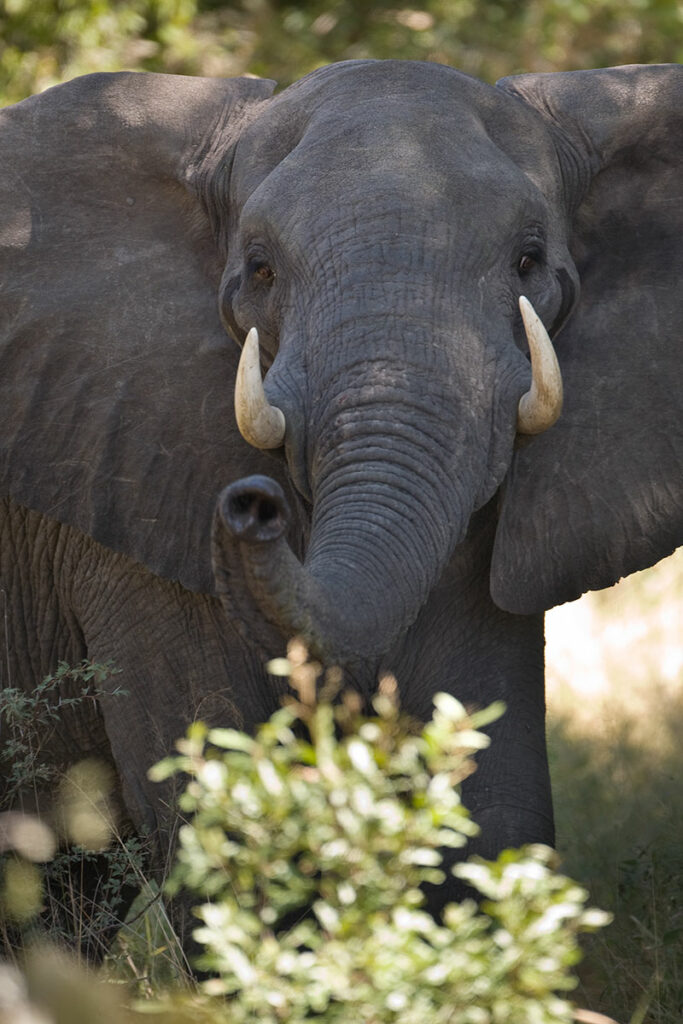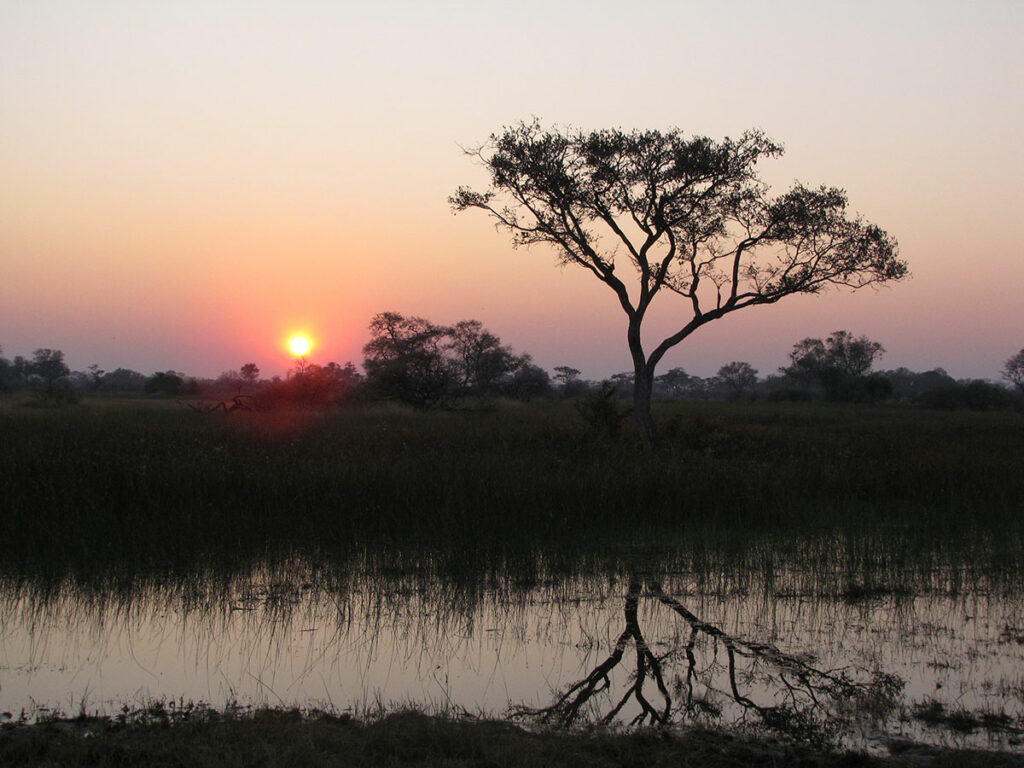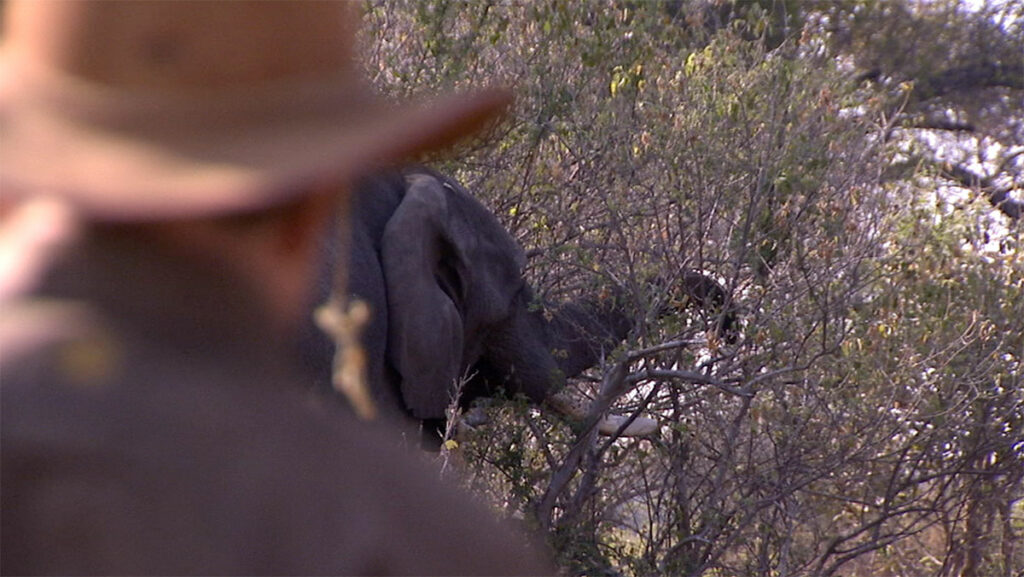Elephant Miles – Part 1
To hunt elephant or not to hunt elephant…that is the question. I debated the proposition for years, weighing the magnificence of the grand pachyderm with the ethic of taking such a unique animal. I had traveled to Africa nearly 20 times, seeing elephants on many safaris for all manner of large and small game, without so much as a thought about hunting them. I had somehow placed elephants on my personal protected list, wondering why anyone would want to hunt them and falling into the rhetorical trap where you justify hunting one species over another—as if one animal has more value than another. As a biologist, I remind myself, it is the population that matters most—not a single animal. If we stray from adherence to practices that sustain overall game populations, we open the door for management by emotion, which ends in devastating consequences for wildlife.

I have often fantasized about asking Dr. Richard Leakey how he now felt about his plan to save elephants in Kenya. His efforts to end elephant hunting in 1973 created an open-season for elephant poachers who decimated that country’s herds. Images of stockpiles of ivory being burned in massive bonfires were broadcast around the world and the good doctor was heralded as the savior of elephants. Without the funds from elephant hunters who paid large sums to hunt the animals, however, there was no money for anti-poaching efforts and there was no one left on the land to care about the fate of the great beasts. By 1989, the country’s elephant population had plummeted to fewer than 20,000 from a high of 275,000. The law of unintended consequences prevailed—as it often does when emotion trumps science and reason—and poachers seized the day, annihilating that nation’s herds and relegating remnant populations to a handful of parks.
With a rampant illicit ivory trade accelerating after the hunting ban, even the country’s president and his wife, Jomo and Ngina Kenyatta and other high-level government officials were allegedly involved in an ivory-smuggling ring that transported tusks out of the country on state-owned planes—more than six tons to China according to one report. Though elephant hunting has been banned in Kenya for more than 40 years, the populations have failed to recover as poaching has not subsided. Voices of western nations—many in Europe—that heralded the hunting ban are nowhere to be heard now, for the groups that chanted loudest for the hunting closure cared more about what funds they could raise off the international press coverage than the actual fate of the elephants.
Despite the outcome of the Kenya hunting closure, the country of Botswana had followed suit in 2014 with its own elephant hunting closure—significantly bowing to international pressure to halt all legal elephant hunting. The results, like Kenya, were disastrous and, in 2019, the country reversed its decision to the great credit of President Masisi—exactly what Kenya should do if they possessed the leadership and will to save their elephants. If history has taught us one lesson about elephants, sport hunting sustains the only management model that will fund protection of the species—eco-tourism alone has failed to protect the herds in every instance. Hunting a few elephants with carefully controlled quotas, in the end, protects the many. Replace emotion with science and the future for elephants across the African continent would be bright. As it is, countries that allow elephant hunting have populations doing far better than nations that have ‘protected’ the beasts. And these facts are indisputable, no matter how inconvenient for animal rights organizations who offer no sustainable way forward.
While I could never hunt a species when it wasn’t biologically justifiable, the question remained: do I want to hunt an elephant? It wasn’t until my 20 or 21st safari that I began to at least contemplate what it would be like to hunt an elephant. My personal sea change happened around a campfire—like many epiphanies in my hunting life–with a professional hunter and elephant hunting client who happened to be sharing our camp.

“What do you like most about elephant hunting,” I inquired.
“There’s nothing like it in the hunting world,” says the PH. “They are smarter and more dangerous than anything else roaming this planet. If an elephant hits you, he finishes you.”
“But it can’t be tough to hunt them, no?”
“Seeing an elephant as you wander around the bush is not the challenge. Hunting an old bull that knows he’s being followed is a different story. They’ll walk up to 100 miles in a day. How easy is that? You should give it a try and then talk to me.”
And that’s when I decided to hunt elephant.
* * *
Every elephant hunt starts with a new frame of mind, an awakening that the stakes are higher—not only for you but for everyone involved. And, when the time comes, the entire hunting party will count on you to save their life by making a clean, killing shot. The alternative is the unthinkable and the stuff of nightmares, so I go into this trip with the sobriety of a wedding proposal.
The edginess of the moment is made extra palpable because we are hunting in the nearly one-million acre Save Conservancy, home to elephants that are refugees of the heavily poached areas of the country’s Gonarezhou National Park. With little funding available, there are no anti-poaching teams to protect the elephants from indiscriminate killing. Many of the surviving persecuted elephants now roam the Conservancy but when they see a human, it’s a flip of the coin as to whether they will charge or run. Take 15,000 pounds and combine it with astonishing speed and you have the deadliest animal on the planet.
The Save was formed by far sighted conservationists who pooled ranches together to form the conservancy in 1992 with no internal fences. They determined that something had to be done or elephants and much of the other wildlife in the region would be surrendered to the snare, poison, and automatic weapons–the preferred tools of poachers. By controlling the boundaries and deploying anti-poaching teams throughout the conservancy, the wildlife populations are flourishing and the funding for that conservancy comes from carefully regulated hunting where the take is limited to what the populations and the land can withstand. Strange as it may sound, that is a novel approach in many parts of Africa, where management is either conducted by popular opinion or isn’t practiced at all. With either approach, the results for animals and the land is regrettable.
With a robust population of elephants roaming throughout the conservancy, almost any hunt can turn into an elephant encounter, so a great deal of plains game is shot with a .375 here—reminiscent of brown bears on Kodiak Island that have something of a Pavlovian response to rifle blasts from blacktail deer hunters. Every professional hunter here carries a large caliber rifle—most in .500 or .577—as it’s the only life insurance worth anything in dangerous game country. And the temperamental elephants of the Save make this stretch of Africa one of the most dangerous.

The elephant hunter’s mantra is use enough gun…or grow wings. It’s not merely a question of being able to kill an elephant, it’s the more pertinent question can you stop it? Plenty a lethally-hit beast has lived long enough to kill the person who inflicted its wounds. And while a professional hunter backing up a client can provide a significant element of safety, close-quarter elephant hunting in thick bush makes the margin for error about the same as the odds of surviving contact with an elephant.
My choice is a .416 Rigby, for the 400-grains of lead are propelled by enough energy to penetrate the sponge and comb of even the biggest of the Zimbabwe giants, some of the continent’s largest pachyderms. And proper elephant hunting means getting in close—10 yards close—to dispatch a frontal or side brain shot. Shooting an elephant behind the shoulder at 100 yards is ivory collecting, not elephant hunting. And there is also a practical reason to get in close so that when it comes time to hit the basketball-sized brain, you increase your chances. You will know in an instant if you hit the brain.
On an elephant hunt in the Okavango Delta with Jeff Rann several years ago, I was carrying a double .458 Winchester. We had spotted a massive old bull feeding on one of the many palm-covered islands of the Delta. After approaching from behind to within 10 yards of the bull, he wheeled-around like a tank getting ready to respond to fire from the flank. In the instant that he squared to face us, I put a 500-grain round between his eyes and he collapsed to the ground like a suddenly deflated Dumbo float at the Macy’s parade. I was certain the frontal brain shot had done its job. Then, in maybe one or two seconds, the stunned bull regained his feet, spun around and started to run off so I broke his hip. The Botswana bulls are the largest bodied elephants in the world and the .458 Win simply didn’t have enough energy to penetrate into the brain, instead it lodged in the spongey bone that sits behind the top of the trunk. Hence the reason the .416 with its small, but greater penetrating bullet is a good choice for any sized elephant. Hunting in the Save means mentally preparing for the frontal brain shot because when you get in close, odds are these bulls will come for you and the frontal brain is the only stopping shot.
“I tell people to shoot the biggest gun you can shoot straight,” says Zayne Van de Merwe, my professional hunter for my entry into this most hallowed of hunting.–Chris Dorsey
Editor’s Note:This essay is adapted from Chris Dorsey’s new book, Director’s Cut, Big game hunting through the lens of the largest outdoor TV producer in history. The book and companion film set is more than a decade in the making with the world’s greatest sporting photographers and cinematographers.

